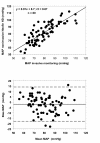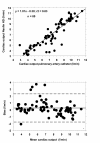Noninvasive cardiac output and blood pressure monitoring cannot replace an invasive monitoring system in critically ill patients
- PMID: 19821993
- PMCID: PMC2766368
- DOI: 10.1186/1471-2253-9-6
Noninvasive cardiac output and blood pressure monitoring cannot replace an invasive monitoring system in critically ill patients
Abstract
Background: Monitoring of cardiac output and blood pressure are standard procedures in critical care medicine. Traditionally, invasive techniques like pulmonary artery catheter (PAC) and arterial catheters are widely used. Invasiveness bears many risks of deleterious complications. Therefore, a noninvasive reliable cardiac output (CO) and blood pressure monitoring system could improve the safety of cardiac monitoring. The aim of the present study was to compare a noninvasive versus a standard invasive cardiovascular monitoring system.
Methods: Nexfin HD is a continuous noninvasive blood pressure and cardiac output monitor system and is based on the development of the pulsatile unloading of the finger arterial walls using an inflatable finger cuff. During continuous BP measurement CO is calculated. We included 10 patients with standard invasive cardiac monitoring system (pulmonary artery catheter and arterial catheter) comparing invasively obtained data to the data collected noninvasively using the Nexfin HD.
Results: Correlation between mean arterial pressure measured with the standard arterial monitoring system and the Nexfin HD was r2 = 0.67 with a bias of -2 mmHg and two standard deviations of +/- 16 mmHg. Correlation between CO derived from PAC and the Nexfin HD was r2 = 0.83 with a bias of 0.23 l/min and two standard deviations of +/- 2.1 l/min; the percentage error was 29%.
Conclusion: Although the noninvasive CO measurement appears promising, the noninvasive blood pressure assessment is clearly less reliable than the invasively measured blood pressure. Therefore, according to the present data application of the Nexfin HD monitoring system in the ICU cannot be recommended generally. Whether such a tool might be reliable in certain critically ill patients remains to be determined.
Figures
References
-
- Forrester JS, Diamond G, Swan HJ. Pulmonary artery catheterization. A new technique in treatment of acute myocardial infarction. Geriatrics. 1971;26:65–71. - PubMed
-
- Forrester JS, Ganz W, Diamond G, McHugh T, Chonette DW, Swan HJ. Thermodilution cardiac output determination with a single flow-directed catheter. Am Heart J. 1972;83:306–311. - PubMed
-
- Leibowitz AB, Oropello JM. The pulmonary artery catheter in anesthesia practice in 2007: an historical overview with emphasis on the past 6 years. Semin Cardiothorac Vasc Anesth. 2007;11:162–176. - PubMed
-
- Antonini M, Meloncelli S, Dantimi C, Tosti S, Ciotti L, Gasparetto A. [The PiCCO system with brachial-axillary artery access in hemodynamic monitoring during surgery of abdominal aortic aneurysm] Minerva Anestesiol. 2001;67:447–456. - PubMed
-
- Ginosar Y, Sprung CL. The Swan-Ganz catheter. Twenty-five years of monitoring. Crit Care Clin. 1996;12:771–776. - PubMed
LinkOut - more resources
Full Text Sources
Other Literature Sources
Medical



